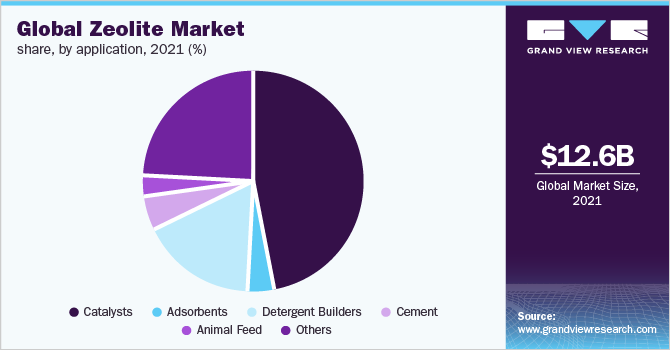Zeolite Market Growth & Trends
The global zeolite market size is expected to reach USD 21.7 billion by 2030, according to a new report by Grand View Research, Inc. The market is expected to expand at a CAGR of 6.2% from 2022 to 2030. The market is expected to be driven by rising capacity expansions in petrochemicals production coupled with investments in water treatment projects and detergent manufacturing. Zeolites are three-dimensional hydrated aluminosilicate minerals with a tetrahedra framework each consisting of four oxygen atoms surrounded by a silicon or aluminum cation.
Based on product, the market is segmented into natural and synthetic. The former is hydrothermal and mostly belongs to volcanic origin. The latter is synthesized in laboratories in different types such as Zeolite A, Type X, Type Y, and others. In terms of revenue, synthetic zeolite dominates the market owing to its increasing demand from chemicals and detergent applications coupled with its high price. In terms of volume, natural zeolite dominates the market. However, the segment growth is anticipated to be low owing to numerous substitutes in the market.
Synthetic zeolites are extensively used as detergent builders to extract water hardness ions and soften the water medium for cleaning and laundry purpose. Rising hygiene concerns, especially after the COVID-19 outbreak, have propelled the production of detergents, and thus, positively influenced the zeolite demand. For instance, the laundry and care business of Henkel observed a growth of over 5% in sales in 2020 owing to a rise in the demand for cleaning products globally.
Based on region, Asia Pacific held the largest revenue share of the global market in 2021. The presence of countries like China and India and rapid investments in manufacturing activities in these countries are propelling the market growth. The countries are facing high production of animal feed, chemicals, and detergents, which is benefitting zeolite demand in the region. For instance, the Zhejiang Petrochemical Daishan Xylene Plant 2 is an upcoming petrochemical project in China with a capacity of 4.8 million tons per annum. In addition, around 500 other projects are anticipated to become operational in the petrochemical industry in China between 2021 and 2025.
The zeolite market is highly competitive in nature. New mediums of low-cost production are projected to open new avenues for market development over the forecast period. For instance, in May 2020, the University of Queensland filed a patent for a newly developed mineral processing technology, which is likely to reduce the cost of zeolite production significantly.
Request a free sample copy or view report summary:
Zeolite Market Report
Report Attribute Details
Market size value in 2022 — USD 13.2 billion
Revenue forecast in 2030 — USD 21.7 billion
Growth Rate — CAGR of 6.2% from 2022 to 2030
Market size volume in 2022 — 6,126.9 kilotons
Volume forecast in 2030 — 8,513.0 kilotons

Zeolite Market Report Highlights
- Factors such as the emergence of coronavirus, currency fluctuations, and unavailability of the workforce have impacted the demand for zeolites. For instance, Albemarle Corporation faced USD 255.4 million lower sales volume in its Catalysts business segment in 2020 from 2019, owing to lower fuel demand due to stay at home orders and travel restrictions worldwide, because of the pandemic
- The threat of substitutes for synthetic zeolite is predicted to remain low since its usage as a catalyst and adsorbent is likely to increase with expansion in the production volumes of chemicals, petrochemicals, and natural gas
- Natural zeolite is likely to face a high threat of substitution from other industrial minerals including diatomite, fuller’s earth, bentonite, gypsum, and silica sand in different applications
- In terms of revenue, the catalysts segment is expected to register a CAGR of 6.7% over the forecast period. Zeolites are widely used as catalysts in various industries including chemical, petrochemical, metal, and mining